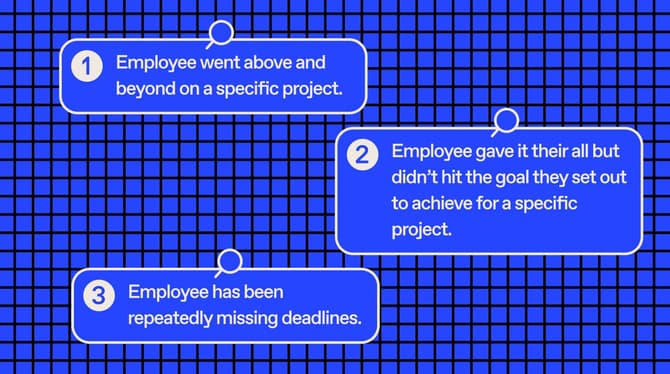Employees are at the heart of every organization's success. If you're a smart leader, this isn't news to you. You also know that employee engagement fuels productivity and helps teams work better. But how do you measure your organization's engagement levels? Are you equipped to keep track of this information and continuously improve it?
Employee engagement surveys can help you assess employee satisfaction, company alignment, wellness, and the overall health of your workplace. How can one tool do so much? Well, surveys gather actionable insights from the source that tell you where your organization is excelling and what can be improved.
Before you jump into surveying, it's crucial to understand the process to implement engagement surveys. Read on to learn about the key steps you don't want to skip.
Assess your organization’s employee experience in minutes

Dive deeper into what is an employee engagement survey
What is an employee engagement survey?
As the name suggests, an employee engagement survey is a survey used to collect data on employee well-being, work satisfaction, employee performance, and other key employee engagement metrics. Such surveys can help human resources professionals and management appraise employee engagement, evaluate company culture, and reexamine organizational values.
Employee engagement surveys involve the entire organization, from senior management to junior staff members, because everyone's feedback counts.
Read our latest guide to learn the ropes of employee engagement surveys, including best practices, survey types and when to use them, and how to interpret the results.
Why conduct an employee engagement survey?
To understand why these surveys are so important, let's first look at the importance of employee engagement and how it plays such a critical role in business success.
Engagement at work closely relates to employee satisfaction, but they aren't interchangeable. Typically, engaged employees feel satisfied with their jobs, but not all satisfied workers are engaged. A laid-back employee can feel pretty content to float along and stay in the organization without working harder, setting career development goals, or promoting the company's vision.
Employee engagement relates to each employee's intrinsic commitment to their job. It's the motivation that fuels an employee's perseverance, sense of purpose, and investment in their work. Engaged employees feel a high sense of loyalty, not just to their own position, but also to the organization as a whole. They understand company objectives, work hard to promote them, and are less likely to consider a position with other organizations.
Companies with a high number of engaged employees have:
- Stronger employee motivation
- Higher productivity
- More sales
- More profits
- Happier customers
How does this translate into numbers? According to a Gallup survey, organizations with the highest levels of engagement were 21% more profitable than organizations with the lowest engagement levels. You can unlock this incentive and many other benefits of employee engagement by measuring it with the right surveys.
What exactly does it mean to measure employee engagement?
Employee engagement isn't a single metric. Rather, it's a complex score that employee engagement surveys help calculate based on several vital elements. To properly measure employee engagement, you should look into:
- An employee's relationship with their direct manager and their peers
- An employee's perception of career advancement opportunities in the organization
- Recognition an employee receives for their hard work
- The alignment between the employee's and the company's values
- Job satisfaction with all its components, including the employee's direct role and compensation
- Overall employee happiness
- Ambassadorship: i.e., how likely the employee is to recommend your organization to other potential employees
4 Steps to implement an employee engagement survey
Effective employee engagement surveys require planning. To make sure your employee engagement survey yields genuine, constructive feedback that helps foster engagement, follow best practices and include these steps in your survey process.
1. Define your goals
Employee engagement surveys may have different aims. Is this your organization's first major employee survey, where you're aiming to get a detailed picture of the employee engagement levels in your organization? Or are you just planning a quick pulse survey?
Have you already implemented changes after a previous survey, and now want to evaluate how your actions have impacted employee engagement? Do you mean to measure employee engagement in a specific department, or get a macro engagement score for your organization?
Defining your goals is a critical part of choosing survey questions. If you aren't sure what direction your survey should take, you can pull from our bank of free employee engagement survey templates.
Also, it's important to focus on engagement when you survey employees. It may be tempting to combine several surveys in one, but an excessively long, meandering survey may lead to survey fatigue and reduce your chances of getting useful employee feedback.
2. Choose the right questions
Measuring employee engagement comes down to asking the right questions. To choose the right employee engagement survey questions, consider factors like the size of your team, survey frequency (i.e., a monthly or an annual survey), and your current data on the engagement rates among your employees.
For instance, your survey questions will change if you sense you have many disengaged employees, versus if you believe the engagement levels in your company have risen since your past employee engagement surveys.
A well-balanced employee engagement survey usually includes several types of questions, namely:
- Yes/No and multiple choice questions: "Always/Sometimes/Never", "Agree/Partially Agree/Disagree"
- Scale-type questions: Scale of 1 to 10
- Open-ended questions, e.g., "What, in your opinion, can we improve?"
The strength of yes/no and scale questions is in the quick, easily quantifiable data they provide. If 60% of your employees marked "No" when asked "Would you say your manager tries their best to help you resolve difficulties at work?", the sign that you should look into employee-manager relationships is clear.
Answers to an open-ended survey question take more effort to group and analyze, but these types of responses in employee engagement surveys may provide valuable insights. If a significant number of employees spontaneously mention a specific issue in the employee engagement survey, the management should pay attention to this trend.
Of course, some of your questions may be more specific to your company culture and recent trends in your organization. For example, if your company switched owners and underwent restructuring, you'll want to see how these shifts influenced employee engagement.
So what questions should your employee engagement survey include? These 35 employee engagement survey questions cover the most common workplace contexts and are a great place to start.
3. Communicate to employees
To improve your survey response rate, it's important to involve your team in the process. Before sending your first employee engagement survey, get your team on board, let them know what to expect, and communicate your main objective.
You can craft a friendly message that underlines the importance of survey participation:
"At the beginning of next week, we're going to send a 10-question employee engagement survey to the whole team. Based on your feedback, we plan to take initiatives that will make our work environment healthier and improve the employee experience in our company."
To reap the benefits of conducting employee engagement surveys, you'll need to gather the entire team's feedback. Having a low participation rate can skew results and leave out important insights that can have a big impact on employee engagement levels.
Before conducting employee engagement surveys, read these 12 tips to increase survey participation.
4. Send the survey
Once you've defined your goals, carefully selected your questions, and communicated to your employees, you're ready to send the employee engagement survey. You can opt to send the survey via a poll on Teams or Google Forms. But if you want to guarantee anonymity, manage results, and track trends over time, your best bet is to use a pulse survey tool like Officevibe.
At this point, you can send another friendly nudge to encourage employees to participate in the survey: "Don't forget to complete the employee engagement survey today! Your feedback helps us make this company a better place to work."
After the team submits their survey responses, acknowledge their efforts with a quick thank-you message and let them know their feedback will drive your employee engagement strategy.
Measure employee engagement results and take action
Once you have your team's responses, it's time to analyze the survey results, identify trends, and consider what actions you can take to improve engagement in your organization. Translating raw data into actionable insights involves recognizing:
- Central themes: What types of recurring employee feedback did the survey results produce? For instance, did a large percentage of your employees mention unreasonable workloads as a major difficulty in their current position?
- Changes compared to previous surveys: Unless this was your first employee engagement survey, you should have readily available statistics from previous surveys focusing on the same metrics. Take this opportunity to see what changed from the last quarter or year and how any changes you have already implemented may have influenced employee engagement.
- Team and department trends: How, judging from the survey data, do various teams and departments compare in terms of satisfaction, productivity, engagement, and other key metrics? If one department lags significantly behind others, you may consider taking a deeper look into this department's practices and how they influence employee engagement.
Segmenting the results of engagement surveys by employee groups may deliver useful insights.
For example, let's say you discover that recently recruited employees show high levels of job satisfaction and engagement, while many senior, experienced employees consider switching organizations.
These results indicate a positive onboarding experience, but also highlight concerns of long-term retention. Here you may call a leadership meeting and brainstorm ways to improve employee retention throughout the employee lifecycle.
Don't get discouraged if external benchmarks show lower engagement rates among your employees compared to workers in other companies. Measuring employee engagement should focus on your specific organization's metric. It's always best to benchmark against yourself using previous engagement scores and survey results. If you see improvement over time, you're on the right track.
Creating an action plan
After analyzing employee survey results, your next step involves planning specific actions. Focus on the areas that require improvement the most and commit to working on them. This will help you promote a healthier employee experience and more productive company culture.
The best plans to improve employee engagement rates include:
- Slow reforms: Significant change may take time. For example, if you discover that many of your employees feel stuck in their career development, you may need time to assess what your organization can do about it (e.g., mentoring programs, sponsored courses, or team restructuring).
- Quick changes: Does your employee engagement survey point to something you can do right now to show your employees you're acting in their best interests? Take advantage of this opportunity. For example, if many employees feel they don't receive manager feedback often enough, make it a point to up your feedback frequency.
- Clear goals: Break down your targets into focused actions with set timelines. For example, instead of saying, "We need to improve team communication," be specific: "All direct managers will email their team at the start of every week with that week's goals."
- Motivated leaders: Who will be responsible for carrying out the plan? Make sure all your managers, team leaders, and HR staff are on board with the proposed actions.
Need more guidance? Follow these 7 steps to build a flawless employee engagement action plan.
Facilitate the process with the right employee engagement survey software
Engaged employees feel heard, valued, and more committed to the organization. Working with the right employee engagement solution can make sure your engagement survey includes the right questions, produces candid feedback, and promotes employee retention.
With powerful tools like Pulse Surveys, Officevibe offers leaders and managers everything you need to nurture a highly engaged workforce and stellar employee experience.
Equip HR and managers with tools to engage, recognize, and drive performance.




